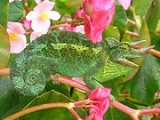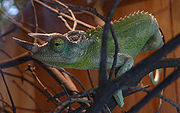
Chamaeleo jacksonii
Encyclopedia
Trioceros jacksonii is an African chameleon belonging to the chameleon family (Chamaeleonidae).
-British
zoologist George Albert Boulenger
in 1896
Its generic
name (trioceros
) is derived from the Greek
τρί- (tri-) meaning "three" and κέρας (kéras) meaning "horns". This is in reference to the three horns found on the heads of males. Its specific name is a Latinized form of English explorer and ornithologist Frederick John Jackson's last name, who was serving as the first Governor of Kenya at the time. The English word chameleon (also chamaeleon) derives from Latin
chamaeleō, a borrowing of the Ancient Greek
χαμαιλέων (khamailéōn), a compound
of χαμαί (khamaí) "on the ground" and λέων (léōn) "lion". The Greek word is a calque
translating the Akkadian
nēš qaqqari, "ground lion".
There are three subspecies, including the nominate:
and Tanzania
, East Africa, found in great numbers at altitudes over 3,000 m. The subspecies merumontanus can only be found on Mount Meru
and the Arusha Region
of Tanzania. The subspecies xantholophus was introduced to Hawaii
in the 1970s and has since established populations on all main islands. This population was the primary source of Jackson's Chameleons for the exotic pet trade. However, the exportation of these animals (and many others) from Hawaii for the pet trade has been made illegal to prevent opportunists from willfully establishing further feral animal populations in order to capture and sell them.
. The female generally have no horns, or traces of the rostral horn (in the subspecies jacksonii and merumontanus). The colouring is usually bright green, with some individual animals having traces of blue and yellow, but like all chameleons it changes colour quickly depending on mood, health, and temperature.
These are small to medium sized chameleons. Their adult size is 12 inches (30 cm) in total length. They have a saw-tooth shaped dorsal ridge. There is no gullar crest. They attain sexual maturity after five months. The lifespan is variable, with males generally living longer than females.
 Jackson's chameleons live primarily on a diet of small insects. They are less territorial than most species of chameleons. Males will generally assert dominance over each other through color displays and posturing in an attempt to secure mating rights, but usually not to the point of physical fights.
Jackson's chameleons live primarily on a diet of small insects. They are less territorial than most species of chameleons. Males will generally assert dominance over each other through color displays and posturing in an attempt to secure mating rights, but usually not to the point of physical fights.
Taxonomy
Jackson's chameleon was first described by BelgianBelgium
Belgium , officially the Kingdom of Belgium, is a federal state in Western Europe. It is a founding member of the European Union and hosts the EU's headquarters, and those of several other major international organisations such as NATO.Belgium is also a member of, or affiliated to, many...
-British
United Kingdom
The United Kingdom of Great Britain and Northern IrelandIn the United Kingdom and Dependencies, other languages have been officially recognised as legitimate autochthonous languages under the European Charter for Regional or Minority Languages...
zoologist George Albert Boulenger
George Albert Boulenger
George Albert Boulenger FRS was a Belgian-British zoologist who identified over 2000 new animal species, chiefly fish, reptiles and amphibians.-Life:...
in 1896
Its generic
Genus
In biology, a genus is a low-level taxonomic rank used in the biological classification of living and fossil organisms, which is an example of definition by genus and differentia...
name (trioceros
Trioceros
Trioceros is a genus in the family Chamaeleonidae. It was previously considered a subgenus of the genus Chamaeleo until 2009 when it was elevated to full genus level.-Species:...
) is derived from the Greek
Ancient Greek
Ancient Greek is the stage of the Greek language in the periods spanning the times c. 9th–6th centuries BC, , c. 5th–4th centuries BC , and the c. 3rd century BC – 6th century AD of ancient Greece and the ancient world; being predated in the 2nd millennium BC by Mycenaean Greek...
τρί- (tri-) meaning "three" and κέρας (kéras) meaning "horns". This is in reference to the three horns found on the heads of males. Its specific name is a Latinized form of English explorer and ornithologist Frederick John Jackson's last name, who was serving as the first Governor of Kenya at the time. The English word chameleon (also chamaeleon) derives from Latin
Latin
Latin is an Italic language originally spoken in Latium and Ancient Rome. It, along with most European languages, is a descendant of the ancient Proto-Indo-European language. Although it is considered a dead language, a number of scholars and members of the Christian clergy speak it fluently, and...
chamaeleō, a borrowing of the Ancient Greek
Ancient Greek
Ancient Greek is the stage of the Greek language in the periods spanning the times c. 9th–6th centuries BC, , c. 5th–4th centuries BC , and the c. 3rd century BC – 6th century AD of ancient Greece and the ancient world; being predated in the 2nd millennium BC by Mycenaean Greek...
χαμαιλέων (khamailéōn), a compound
Compound (linguistics)
In linguistics, a compound is a lexeme that consists of more than one stem. Compounding or composition is the word formation that creates compound lexemes...
of χαμαί (khamaí) "on the ground" and λέων (léōn) "lion". The Greek word is a calque
Calque
In linguistics, a calque or loan translation is a word or phrase borrowed from another language by literal, word-for-word or root-for-root translation.-Calque:...
translating the Akkadian
Akkadian language
Akkadian is an extinct Semitic language that was spoken in ancient Mesopotamia. The earliest attested Semitic language, it used the cuneiform writing system derived ultimately from ancient Sumerian, an unrelated language isolate...
nēš qaqqari, "ground lion".
There are three subspecies, including the nominate:
- Trioceros jacksonii jacksonii Boulanger 1896 : Jackson's Chameleon
- Trioceros jacksonii merumontanus Rand 1958 : Dwarf Jackson's Chameleon
- Trioceros jacksonii xantholophus Eason, Ferguson & Hebrard 1988 : Yellow-crested Jackson's Chameleon
Location
Jackson's Chameleons are native to the humid, cooler regions of KenyaKenya
Kenya , officially known as the Republic of Kenya, is a country in East Africa that lies on the equator, with the Indian Ocean to its south-east...
and Tanzania
Tanzania
The United Republic of Tanzania is a country in East Africa bordered by Kenya and Uganda to the north, Rwanda, Burundi, and the Democratic Republic of the Congo to the west, and Zambia, Malawi, and Mozambique to the south. The country's eastern borders lie on the Indian Ocean.Tanzania is a state...
, East Africa, found in great numbers at altitudes over 3,000 m. The subspecies merumontanus can only be found on Mount Meru
Mount Meru (Tanzania)
Mount Meru is an active stratovolcano located west of Mount Kilimanjaro in the nation of Tanzania. At a height of , it is visible from Mt Kilimanjaro on a clear day, and is the tenth highest mountain in Africa. Much of its bulk was lost about 8,000 years ago due to an eastward volcanic blast,...
and the Arusha Region
Arusha Region
Arusha is one of Tanzania's 26 administrative regions. The regional capital and largest city is Arusha. Other towns include Monduli, just west of Arusha, Longido and Loliondo to the north, Mto Wa Mbu and Karatu to the west and Usa River to the east...
of Tanzania. The subspecies xantholophus was introduced to Hawaii
Hawaii
Hawaii is the newest of the 50 U.S. states , and is the only U.S. state made up entirely of islands. It is the northernmost island group in Polynesia, occupying most of an archipelago in the central Pacific Ocean, southwest of the continental United States, southeast of Japan, and northeast of...
in the 1970s and has since established populations on all main islands. This population was the primary source of Jackson's Chameleons for the exotic pet trade. However, the exportation of these animals (and many others) from Hawaii for the pet trade has been made illegal to prevent opportunists from willfully establishing further feral animal populations in order to capture and sell them.
Reproduction
Most chameleons are oviparous, but Jackson's Chameleon gives birth to live offspring: 8 to 30 live young are born after a five to six month gestation. The subspecies merumontanus gives birth to 5-10 live young.Description
They are sometimes called Three-horned Chameleons because males possess three brown horns: one on the nose (the rostral horn) and one above each superior orbital ridge above the eyes (preocular horns), somewhat reminiscent of the ceratopsid dinosaur genus TriceratopsTriceratops
Triceratops is a genus of herbivorous ceratopsid dinosaur which lived during the late Maastrichtian stage of the Late Cretaceous Period, around 68 to 65 million years ago in what is now North America. It was one of the last dinosaur genera to appear before the great Cretaceous–Paleogene...
. The female generally have no horns, or traces of the rostral horn (in the subspecies jacksonii and merumontanus). The colouring is usually bright green, with some individual animals having traces of blue and yellow, but like all chameleons it changes colour quickly depending on mood, health, and temperature.
These are small to medium sized chameleons. Their adult size is 12 inches (30 cm) in total length. They have a saw-tooth shaped dorsal ridge. There is no gullar crest. They attain sexual maturity after five months. The lifespan is variable, with males generally living longer than females.

External links
- Jackson's Chameleon Care Information at Caresheets.net
- Chamaeleo jacksonii information from HEAR
- Preliminary study of the behavior and ecology of Jackson's chameleons of Maui, Hawaii (Dr. George H. Waring, Dept. of Zoology, Southern Illinois University)

